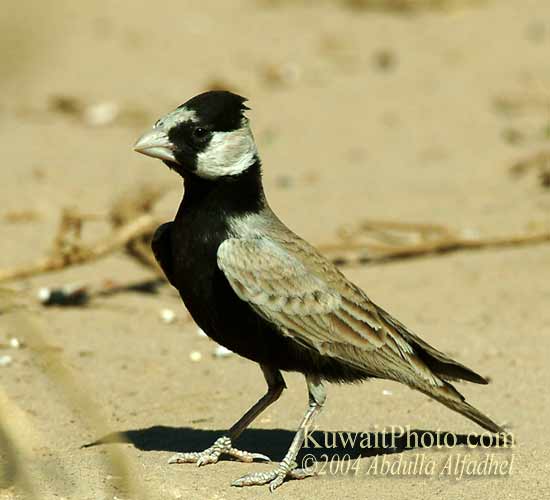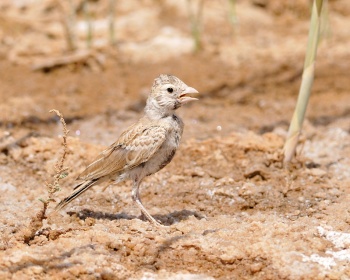
- Eremopterix nigriceps
Identification
11.5-12.5cm
Male
- White forehead, cheeks, sides of neck, and nape
- Black crown and collar
- Black stripe through eye to base of bill, and lower border of cheek
- Black underparts
- Upperparts greyish brown
Female - mainly pale brown and streaked
Distribution
Africa, Middle East and Asia
Northern Africa: Morocco, Egypt
Western Africa: Mauritania, Senegal, Mali, Burkina Faso, Niger, Chad
Eastern Africa: Sudan, Eritrea, Ethiopia, Djibouti, Somalia
African Islands: Cape Verde
Middle East: Arabian Peninsula, Saudi Arabia, Yemen, Socotra, Oman, United Arab Emirates, Qatar, Bahrain Kuwait, Iraq, Iran
Asia: Pakistan, India, Sri Lanka
Very occasional straggler to Algeria, Israel and Jordan.
Taxonomy
Subspecies[1]
Four subspecies are recognised:
- E. n. nigriceps:
- E. n. albifrons:
- Southern Morocco to Mauritania, Mali, Chad and western Sudan
- E. n. melanauchen:
- E. n. affinis:
Habitat
Dry savanna, semi desert and flat, sandy areas of desert with sparse vegetation.
Behaviour
See reference 3. below for a detailed account.
Diet
The diet is principally seeds but insects are taken.
Breeding
Monogamous. The female only builds the cup-shaped nest with the male in close proximity; the rim of nest is surrounded by small pebbles or sand/mineral concretions whenever the nest is placed in loose, sandy terrain.
The clutch consits of 2 or 3 eggs which are incubated by both sexes for 11–12 days. Both parents incubate, (about 25% of the time by the male.) The young are fed by both adults, mainly with insects and their larvae.
The young leave the nest after eight days and begin to fly after 14 or 15 days. After leaving the nest, each parent cares for one single chick. Any third chicks are usually runts and die before leaving the nest, sometimes seemingly rejected by the parents.
References
- Clements, JF. 2009. The Clements Checklist of Birds of the World. 6th ed., with updates to December 2009. Ithaca: Cornell Univ. Press. ISBN 978-0801445019.
- Avibase
- Morgan J.H. and J. Palfrey "Some notes on the Black-crowned Finch-Lark" 1986 Sandgrouse 8: 58-73
- Ansers.com
Recommended Citation
- BirdForum Opus contributors. (2024) Black-crowned Sparrow-Lark. In: BirdForum, the forum for wild birds and birding. Retrieved 26 April 2024 from https://www.birdforum.net/opus/Black-crowned_Sparrow-Lark
External Links
GSearch checked for 2020 platform.1





